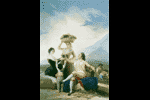| Works in
Rococo Style Blindman's Bluff

The Harvest

La Maja

Realist
and Romantic Works
Self Portrait

"Goya's
skills were recognized early on, and in 1786 he was
appointed Pintor del Rey (Painter to the King). In
this capacity (he was promoted to First Court Painter in
1799) Goya produced works such as The Family of Charles
IV. Here King Charles IV and Queen Maria Luisa are
surrounded by their children. As a court painter and
artist enamored with the achievements of his predecessor
Diego Velazquez,
Goya appropriately used Velazquez's Las Meninas as
his inspiration for this image. As in Las Meninas, the
royal family appears facing viewers in an interior space
while the artist included himself on the left, dimly
visible, in the act of painting on a large canvas."
- Gardner's
Art Through The Ages,
11th edition, Vol. II, p. 865
The family of Carlos IV
(image is reversed)

"Goya did not arrive at his general dismissal of
Neoclassicism without considerable thought about the
Enlightenment and the neoclassical penchant for rationality
and order. This reflection emerges in works such as
The Sleep of Reason Produces Monsters, an etching from a
series titled Los Caprichos (The Caprices). In this
print Goya depicted himself asleep, slumped onto a table or
writing stand, while threatening creatures converge on him.
Seemingly poised to attack the artist are owls (symbols of
folly) and bats (symbols of ignorance). Viewers might
read this as a portrayal of what emerges when reason is
suppressed and, therefore, as advocating Enlightenment
ideals. However, it also can be interpreted as Goya's
commitment to the creative process and the Romantic spirit -
the unleashing of imagination, emotions, and even
nightmares."
- Gardner's
Art Through The Ages,
11th edition, Vol. II, p. 865
When Reason Sleeps

| Conflict was precipitated when Portugal refused to
comply with Napoleon’s
Continental System. By a secret convention reached
at Fontainebleau (Oct., 1807) Spain agreed to support
France against Portugal. A French army under Andoche
Junot occupied (Nov., 1807) Portugal, and King
John VI and his family fled to Brazil without
resisting. Napoleon then began a series of maneuvers to
secure Spain for France. On the pretext that they were
reinforcements for Junot, large numbers of French troops
entered Spain and seized Pamplona and Barcelona (Feb.,
1808). On Mar. 23 French marshal Joachim
Murat entered Madrid. |
2 |
| Meanwhile, a palace revolution (Mar. 19) had deposed
King
Charles IV and his favorite,
Godoy, and had placed
Ferdinand VII on the throne. However, Charles and
Ferdinand were called to Bayonne by Napoleon, and
coerced to abdicate (May 5–6) in favor of Napoleon’s
brother Joseph
Bonaparte. A bloody uprising in Madrid (May
2)—immortalized in Francisco de
Goya’s paintings—was put down by Murat and on June
15 Joseph was proclaimed king of Spain. |
-
http://www.bartleby.com/65/pe/PeninWar.html
"The Spanish people finally recognizing the French as
invaders, sought a way to expel the foreign troops. On
May 2nd, 1808, in frustration, the Spanish attacked the
Napoleonic soldiers in a chaotic and violent clash. In
retaliation and as a show of force, the French responded the
next day by executing numerous Spanish citizens.
"In
emotional fashion, Goya depicted the anonymous murderous
wall of Napoleonic soldiers ruthlessly executing the unarmed
and terrified Spanish peasants. The artist encouraged
viewer empathy for the Spanish by portraying horrified
expressions and anguish on their faces, endowing them with a
humanity absent from the firing squad. Further, the
peasant about to be shot throws his arms out in a cruciform
gesture, providing a parallel to Christ.
"Goya heightened the drama of this event through his stark
use of darks and lights. In addition, Goya's choice of
imagery extended the time frame, and thus the tragedy's
emotion. Although he captured a specific moment when
one man is about to be executed, others lie dead at his
feet, their blood staining the soil of Principe Pio hill,
while many others have been herded together to be
subsequently shot."
- Gardner's
Art Through The Ages,
11th edition, Vol. II, p. 867
May 3rd

Madhouse

The Black
Paintings
"Over time, Goya became increasingly disillusioned and
pessimistic; his declining health only contributed to his
state of mind. Among his later works is a series of
frescoes called the "Black Paintings." Goya painted
these frescoes on the walls of his farmhouse in Quinta del
Sordo [House of the Deaf Man], outside Madrid. Because
Goya created these works solely on his terms and for his
viewing, one could argue that they provide great insight
into the artist's outlook. If so, the vision is
terrifying and disturbing."
- Gardner's
Art Through The Ages,
11th edition, Vol. II, p. 867
Battle with Cudgels

"Goya's
work, rooted both in a personal and national history,
presents darkly emotional images well in keeping with
Romanticism. The demons that haunted Goya emerged in
his art. As historian Gwyn Williams nicely sums up, '
As for the grotesque, the maniacal, the occult, the
witchery, they are precisely the product of the sleep of
human reason; they are human nightmares.
That these monsters are human is, indeed the point.' "
- Gardner's
Art Through The Ages,
11th edition, Vol. II, p. 867
Witches' Sabbath

"Saturn Devouring One of His
Children, one of the Black Paintings, depicts the raw
carnage and violence of Saturn (the Greek Kronos...), wild
eyed and monstrous, as he consumes one of his children.
Because of the similarity of Kronos and Khronos (the Greek
word for time), Saturn has come to be associated with time.
This has led to an interpretation of Goya's painting about
the artist's despair over the passage of time. Despite
the image's simplicity, it conveys a wildness, boldness, and
brutality that cannot help but evoke an elemental response
from any viewers."
- Gardner's
Art Through The Ages,
11th edition, Vol. II, p. 867
Saturn devouring his son

Dog Drowning

|